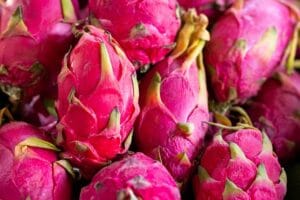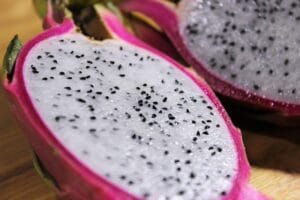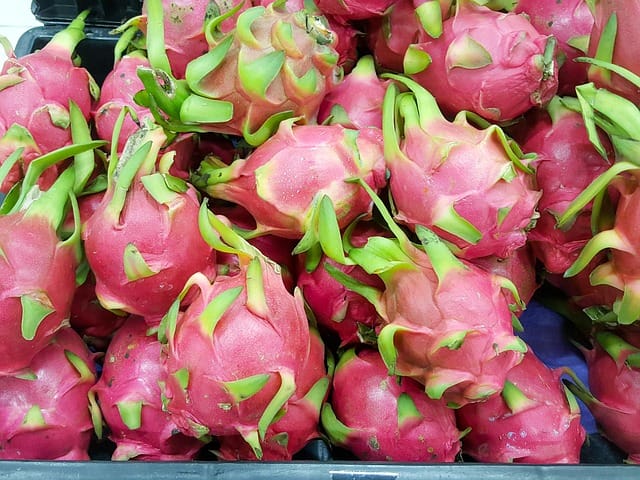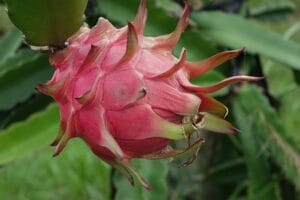Introduction
Dragon fruit, also known as pitaya, is a tropical fruit known for its vibrant pink skin, white or red flesh, and tiny black seeds. Native to Central America but now grown globally, dragon fruit is not just delicious and packed with nutrients — it also makes an attractive ornamental plant.
The good news? You don’t need a farm or even a backyard to grow dragon fruit. With the right pot, a sunny spot, and a bit of patience, you can easily grow this exotic fruit right at home. Whether you’re a gardening newbie or looking to expand your home garden, this step-by-step guide will teach you exactly how to grow dragon fruit in pots, from planting to harvesting. Let’s get started!
| Feature | Details |
| Common Names | Dragon Fruit, Pitaya, Strawberry Pear |
| Scientific Name | Hylocereus undatus |
| Plant Type | Climbing cactus |
| Sunlight | Full sun (6–8 hours daily) |
| Soil Type | Well-draining, sandy or loamy soil |
| Watering | Moderate; let soil dry between watering |
| Growth Time | 6–8 months for cuttings, 2+ years from seed |
| Fruit Season | Summer to early fall |
How to grow Dragon fruit plant
There are some steps to grow a Dragon fruit plant that you know.
Watering
Dragon fruit plants require moderate but consistent watering. Overwatering can lead to root rot, while underwatering can stunt growth. Always check the top inch of soil—if it feels dry, it’s time to water. During hot summer months, water every 2–3 days; in cooler seasons, reduce to once a week. Use pots with good drainage and avoid letting the plant sit in standing water. Early morning or late evening watering is ideal to minimize evaporation. During flowering and fruiting, keep the soil slightly moist but not soggy. Proper watering ensures healthy growth and improves fruit quality in potted dragon fruit plants.
Light & Temperature
Dragon fruit thrives in full sunlight, needing at least 6 to 8 hours of direct sun daily for optimal growth and fruiting. Place the plant in a bright location, such as a south-facing balcony or terrace. Inadequate light can result in weak stems and poor fruit production. Dragon fruit prefers warm temperatures between 20°C to 35°C (68°F to 95°F). It is sensitive to frost and cold winds, so if you live in a cooler region, bring the pot indoors during winter or use protective covers. Consistent warmth and sunlight are key to a healthy, productive plant.

Soil
Dragon fruit thrives best in well-draining, slightly acidic to neutral soil with a pH range of 6.0 to 7.0. The ideal soil mix should be light, airy, and rich in organic matter to support healthy root development. A combination of garden soil, sand, or perlite, and compost works well for potted plants. Avoid clay-heavy soils, as they retain too much water and can lead to root rot. You can also use a commercial cactus or succulent mix for optimal drainage. Good soil ensures better nutrient absorption, healthier growth, and more productive flowering and fruiting in dragon fruit plants.
Fertilizer
Fertilizer plays a vital role in the healthy growth and fruit production of dragon fruit plants. Use a balanced fertilizer, such as 10-10-10 NPK, during the growing season to support overall plant development. Apply it once a month from spring through summer. As the plant enters its flowering stage, switch to a phosphorus-rich fertilizer to encourage blooming and fruiting. Organic options, such as vermicompost, bone meal, or banana peel compost, can also be highly effective. Always water the plant after fertilizing to help nutrients reach the roots. Avoid over-fertilizing, as it may cause excessive vegetative growth with fewer fruits and weaker stems.
Pruning & Maintenance
Pruning is essential to keep your dragon fruit plant healthy, manageable, and productive. Regularly trim away dead, damaged, or overcrowded stems to improve airflow and sunlight exposure. Focus on shaping the plant around its support structure, such as a pole or trellis, to encourage vertical growth and strong fruit-bearing branches. After fruiting, remove any spent stems to redirect the plant’s energy. Always use clean, sharp tools to prevent the transmission of diseases. Minimal but consistent maintenance—like checking for pests and clearing fallen debris—helps prevent fungal infections and keeps your plant thriving in pots for years. Pruning also boosts flowering and fruit yield.
Flowering and Pollination
Dragon fruit plants produce large, fragrant, white flowers that bloom only at night and usually last for just one night. These flowers are often pollinated by bats or moths in nature. However, when grown at home, especially in pots, hand pollination may be necessary to ensure fruit development. Use a small, soft brush or cotton swab to transfer pollen from one flower to another, ideally between 9 PM and 2 AM, when flowers are fully open. Some varieties are self-pollinating, while others need cross-pollination, so growing more than one plant can help improve fruit yield.
How to Harvest a Dragon Fruit Plant
Harvesting dragon fruit is simple but requires timing and care. The fruit is ready to pick about 30 to 50 days after flowering, when it turns bright pink or red and the scales begin to wilt slightly. Gently twist or cut the fruit off the stem using garden shears—avoid pulling it forcefully. For the best taste, harvest in the morning when it’s cool. Don’t wait too long, as overripe fruit may split or lose flavor. Wear gloves if needed, as the plant has small spines. After harvesting, store dragon fruit in a cool place or refrigerate it.
Best Soil Mix for Dragon Fruit
- Dragon fruit needs well-draining soil to prevent root rot.
- Use a cactus or succulent potting mix, or make your own:
- 2 parts garden soil
- 1 part coarse sand or perlite
- 1 part compost or cocopeat
Add crushed eggshells or bone meal to enrich the soil with calcium.
Common Problems and Solutions
| Problem | Cause | Solution |
| Yellowing leaves | Overwatering or poor drainage | Check drainage, reduce watering |
| Stem rot | Fungal infection | Cut affected part, treat with fungicide |
| No flowers | Not enough sunlight or nutrients | Increase sun exposure, use phosphorus-rich fertilizer |
| Pest attack | Aphids or mealybugs | Use neem oil spray or insecticidal soap |
dragon fruit plant price
Buy the cheapest and best organic Dragon Fruit plant sapling for planting for sale online, delivered near me. Price Rs 79/-. Free delivery above Rs 150
small dragon fruit plant
A small dragon fruit plant is a young cactus with fleshy, green, triangular stems that may be just a few inches tall. Ideal for pots or containers, it needs support to climb and thrive. With proper sunlight and care, it can grow rapidly and eventually produce beautiful flowers and fruits.
Benefits of Growing Dragon Fruit at Home
- Fresh, organic fruit supply
- Rich in antioxidants, fiber, and vitamin C
- Beautiful cactus-like appearance
- Air-purifying qualities
- Great for containers and small spaces
baby dragon fruit plant
A baby dragon fruit plant is a young cactus vine just beginning to grow from seed or cutting. At this stage, it features soft, green, fleshy stems with small spines and needs gentle care. Place it in indirect sunlight, water lightly, and ensure well-draining soil. With proper support and attention, this baby plant will develop into a climbing vine, eventually producing beautiful flowers and delicious dragon fruits.
How to plant dragon fruit cuttings
- Take a 12–18 inch cutting from a healthy dragon fruit stem.
- Let it dry in shade for 2–3 days to form a callus.
- Plant 2–3 inches deep in moist soil.
- Water lightly and place in a warm, sunny spot.
How to plant dragon fruit seeds
- Scoop out seeds from ripe dragon fruit and wash them.
- Dry for a day and sow in seed trays or small pots.
- Germination takes 1–2 weeks.
- Transplant to larger pots once seedlings are 5–6 inches tall.
Dragon fruit plant benefits
The dragon fruit plant offers a range of impressive benefits. It produces nutrient-rich fruit packed with antioxidants, vitamin C, fiber, and essential minerals that support digestion, boost immunity, and improve skin health. The plant itself is low-maintenance and ideal for home gardening, even in pots. It also purifies the air and adds a tropical touch to your space with its striking appearance. Dragon fruit plants are drought-tolerant and can thrive in hot climates, making them eco-friendly. Plus, growing your dragon fruit at home ensures access to fresh, organic produce while promoting a healthy and sustainable lifestyle.

FAQ
Can I grow dragon fruit at home?
Yes, it is possible to grow dragon fruit at home, either from seeds or cuttings. Dragon fruit is relatively easy to grow in warm, tropical conditions, making it suitable for many home gardens in India, including those with limited space. Success depends on choosing the right location, soil, and providing adequate support for the plant as it grows.
How long does dragon fruit take to grow?
Dragon fruit plants typically take 2-3 years to produce their first fruit when grown from cuttings, according to FarmAtma, and 3-4 years when grown from seed. While the first fruits may appear within this timeframe, peak fruit production is generally reached in the 3rd to 5th year after planting.
Is a dragon fruit plant a cactus?
Dragon fruit is an incredible cactus that produces strange-looking fruit resembling a magical dragon egg. Cut through the vibrant pink-red skin to reveal white or pink flesh speckled with tiny black seeds.
Why is dragon fruit so expensive?
Dragon fruit is expensive due to a combination of factors, including high import costs, limited domestic cultivation, and specific growing requirements. The fruit is not native to many regions and requires specific climatic conditions, leading to reliance on imports. Additionally, its delicate nature and high demand contribute to its premium price.
Can dragon fruit grow in pots?
Yes, dragon fruit can be grown in pots, particularly in areas with limited space or colder climates. It’s a good option for those wanting to cultivate this tropical fruit at home.
How many dragon fruits per plant?
A healthy, mature dragon fruit plant can produce between 20 to 30 kg of fruit per year, which translates to approximately 40 to 100 fruits per wave, with multiple waves (3-4) throughout the fruiting season. The total yield per plant can vary depending on factors like variety, growing conditions, and pollination.
Which dragon fruit is best?
The “best” dragon fruit variety often comes down to personal preference, but yellow dragon fruit is widely considered the sweetest and most flavorful. Red and white dragon fruits are also popular, with red varieties generally offering more antioxidants and potentially a sweeter taste than white ones.
How much is one kg of dragon fruit?
KSh 595. Energize your senses with Dragon Fruit per kg! This exotic fruit is bursting with vitamins, minerals, antioxidants, and a refreshing, mildly sweet taste.
How many months will dragon fruit grow?
Dragon fruit, when grown from cuttings, can start producing fruit in as little as 6 to 12 months, but it typically takes 18-24 months after planting to see significant yields. If grown from seeds, it can take 5 years or more to reach maturity and produce fruit.
Conclusion
Growing dragon fruit at home in pots is a fun and rewarding experience — even for beginners. With the right care, soil, and sunlight, this unique cactus can thrive in a balcony, terrace, or sunny window, offering both tropical beauty and sweet, exotic fruits. Follow this guide step by step, and soon you’ll be harvesting your very own dragon fruits at home.





